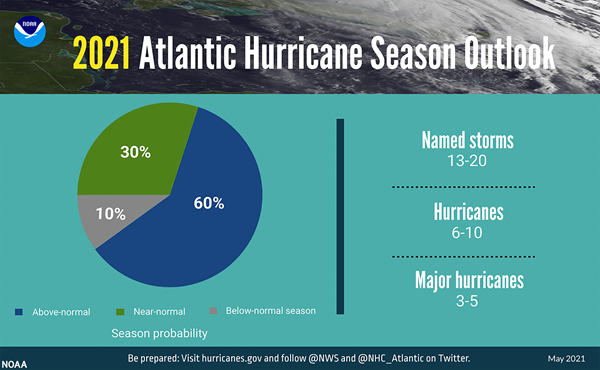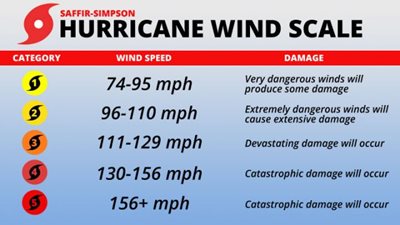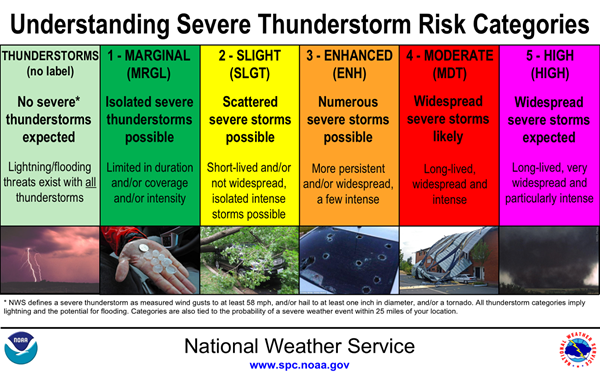Hurricane season has begun. Associations throughout Texas should take heed and start strategizing now in tandem with management partners to develop a comprehensive emergency plan that outlines community response to hurricanes. Some preparation is obvious. Board up windows. Move lightweight objects inside. Have a mass communication plan for residents and educate them on building escape and evacuation routes. Make sure you have copies of important association documents.
However, many boards can overlook additional severe weather issues before and after a hurricane makes landfall, especially if your community isn't on the coast but may still be impacted. Let's take a look at the upcoming Texas hurricane season. What should board members expect? Could your community be exposed to hurricane-related severe weather? How can your association prepare? What issues might your COA or HOA be overlooking?
While the start of hurricane season is officially June 1, Ana appeared at the end of last week, beating out a local tropical depression off the Texas coast to become the first named storm of hurricane season 2021. The National Oceanic and Atmospheric Administration (NOAA) issued its 2021 Atlantic hurricane season outlook on May 21, 2021. The numbers put communities across Texas on the watch list to expect yet another "above-average" stormy summer.
An average hurricane season produces 14 named storms, 7 of which become hurricanes, and 3 of those will be major hurricanes. For 2021, the U.S. has a 60% chance of above-normal storm development. Here's how the numbers break down:

Looking Back: How 2020 set the benchmark for Hurricane seasons and response in Texas
Texas received its fair share of hurricane activity in 2020, with 8 out of 30 named storms appearing in the Gulf of Mexico. It was one of the busiest storm seasons on record. It was only the second time in history that the list of standard names was exhausted, and NOAA was forced to move into the Greek alphabet. Last year also made a new record with the formation of storm Iota, three storms past the previous record Zeta in 2005.
No matter how many storms form in Texas hurricane season 2021, the reality is that it only takes one to impact a community dramatically. Let's take a look at the physical and financial impact on Texas communities from last year's storms:
Hurricane Hanna
- Made landfall July 25, 2020, South Texas
- Category 1 hurricane
- High winds caused structural damage in over 40% of affected homes
- Flash flooding and rainfall over 15 inches
- Hanna's outer bands caused 5 tornadoes to touch down
- 194,000 people lost power in Rio Grande Valley
- Estimated damage: Over $1.2 billion
Hurricane Laura 
- Made landfall August 27, 2020, Texas – Louisiana border, just missing Texas coasts
- Category 4 hurricane
- Mandatory evacuations of 385,000 people in four coastal counties
- Voluntary evacuation of Harris County, including Houston metro area
- Flash flooding and rainfall over 10-15 inches
- Laura's outer bands produced over 16 tornadoes
- 186,000 without power in South Texas
- Estimated damage: $19.1 billion
Notice anything about these facts? While the hurricane winds and storm surge up the coast cause damage directly tied to the main battery, a great deal of damage results from related weather events – flooding, extensive rainfall, hail and tornadoes.
Even if your community is not located on the coast, these extreme weather offshoots can still bring your community or building problems.
What kinds of severe weather can occur in conjunction with hurricanes?
Storm Surge
Considered the greatest risk to life and property on the coast. A storm surge is a large dome of water, 50 to 100 miles wide, that sweeps across the coastline near where a hurricane makes landfall. It can be more than 15 feet deep at its peak.
Severe Thunderstorms/Hailstorms
Severe storms are almost guaranteed to run before a hurricane in the outer rain bands, often accompanied by increased lightning strikes. The chart below explains the various intensities of these storms you may hear during hurricane weather broadcasts. While some hail may occur in these thunderstorms, it rarely happens during the hurricane itself. Several factors influence this, but mostly it's due to the warm tropical core of storms that typically melts hail before it reaches the ground.

Tornadoes
Tornadoes created in hurricanes' outer rain bands because these bands often contain multiple thunderstorm cells of their own. Most tornadoes occur within 150 miles of landfall, but it's important to note that they can also continue to form for days after a hurricane makes landfall. The National Weather Service's Doppler radar systems can only provide indications of tornadoes from a few minutes to about 30 minutes in advance, so it's critical that your community or building has a severe weather plan before one occurs.
Flooding
Hurricanes are identified partly due to the spiral bands of heavy showers that circle inward toward the storm's center or "eye." These bands can range out to miles wide and 50 to 300 miles long. While the eye often has light wind and a clear sky, the "eyewall" is a ring of clouds that swirl tightly at the outer edge and has the heaviest precipitation and strongest winds. The amount of rain typically produced by hurricanes is anywhere from 6 to 12 inches.However, Texas hurricane storm systems can stall once landfall occurs and produce long-term flooding, as Hurricane Harvey (2017) demonstrated, where the Harris county final report indicated an average of 26 to 47 inches across the county for four days.
How should my association prepare for a Texas hurricane?
Some specific elements of hurricane preparation are unique to HOAs and COAs, and these are outlined in the Hurricane Guide available to view and share by filling out the form on this page.
More helpful articles
- How Your Property Management Company is Your Friend During Hurricane Season
- Hurricane Plans and Policies: Reduce Your Association's Risk
- Simple Landscaping Tips To Help You Prepare for Hurricane Season
- How Your Property Management Company Should Help Your Community after a Major Storm
What other issues may impact my association because of severe weather or a hurricane?
We've located six areas that your association board should take into account when establishing an strategic emergency plan for your community or building.
1. Shelter space
We hope that during this 2021 season, mandatory evacuations of Texas communities will not be needed. However, keep in mind that in many counties, shelters are still operating under CDC guidance in terms of physical distancing, so space is limited. Face coverings may be required while the displaced are housed. Most cities have a department that handles emergency management and planning. As a precaution, contact them to request a list of shelter locations and requirements to provide to your residents ahead of a severe storm.2. Supply shortages
We've all seen the store shelves as the news coverage warns of impending storms. Suddenly, basics like bottled water, canned food, cleaning supplies and trash bags are hard to come by. Avoid the panic by advising your residents to stockpile a week's worth of basic supplies for each family member in their pantry before storm season hits.Remember, these supplies may need to include diapers and formula for infants, feminine hygiene supplies, or other non-food supplies. Also, remember that if your association intends to run generators for basic power, you may need extra gas supplies. Flooded roads can delay gas deliveries in storm-affected regions.
3. Utility services
With high winds come downed power lines and trees, while flooding can back up sewer systems and debris can block water lines. Ensure that your board has a plan to consistently update residents on the current status of city or municipal restoration efforts, keeping in mind that email access is typically limited when electricity isn't available.
4. Competition for Vendors
In the wake of weather events, the competition to book insurance adjustors and vendors is fierce as many associations and private non-HOA residents seek to assess damages and start restoration projects. Develop a "vendor guide" in partnership with your management company and community/general manager. The guide should list your preferred contractors, as well as their point of contact.
Pro Tip: An on-the-ball manager will have a strategic plan to schedule consultations
ahead of a storm to beat the rush of phone calls afterward.
A word of caution. Texas has perennially seen out-of-state contractors swarming to affected areas to help ease the burden of overwhelmed service providers. Thoroughly vet the contractor to ensure they are properly licensed and insured to do the necessary scope of work. Try not to be swayed by deals offered that seem too good to be true, as many associations have found themselves in need of additional repairs after rapid but substandard restoration work.
5. Insurance Coverages
Many associations have experienced a devasting weather event to find that their insurance doesn't fully cover necessary repairs. Your management partner should work with a certified insurance brokerage that specializes in the unique policy needs of HOA and COA. Watch Insurance Insiders: Policies & Preparation to get professional advice on proper coverage and potential gaps in your association's coverage.
6. Construction Costs
Markets across Texas and the nation are currently seeing all-time highs for lumber, sheet metal, and other construction supplies. According to the National Association of Home Builders (NAHB), the cost of lumber used in home building as of April 23, 2021, has increased by nearly 250%. Similar increases have been identified for other construction materials and imported replacement parts. This means that your association may need to have a plan to supplement reserve funding in anticipation of rising replacement costs, especially if your board doesn't have an updated reserve study. Ask your management partner if they have banking partnerships to provide emergency lines of credit or preferred loan rates.Planning for hurricane season doesn't have to be overwhelming. Our Hurricane Preparedness guide includes step-by-step preparation, checklists, and more. With the help of a great property management company, even seemingly great damage can be mitigated, repaired and reversed. To find out more, contact FirstService Residential Texas.